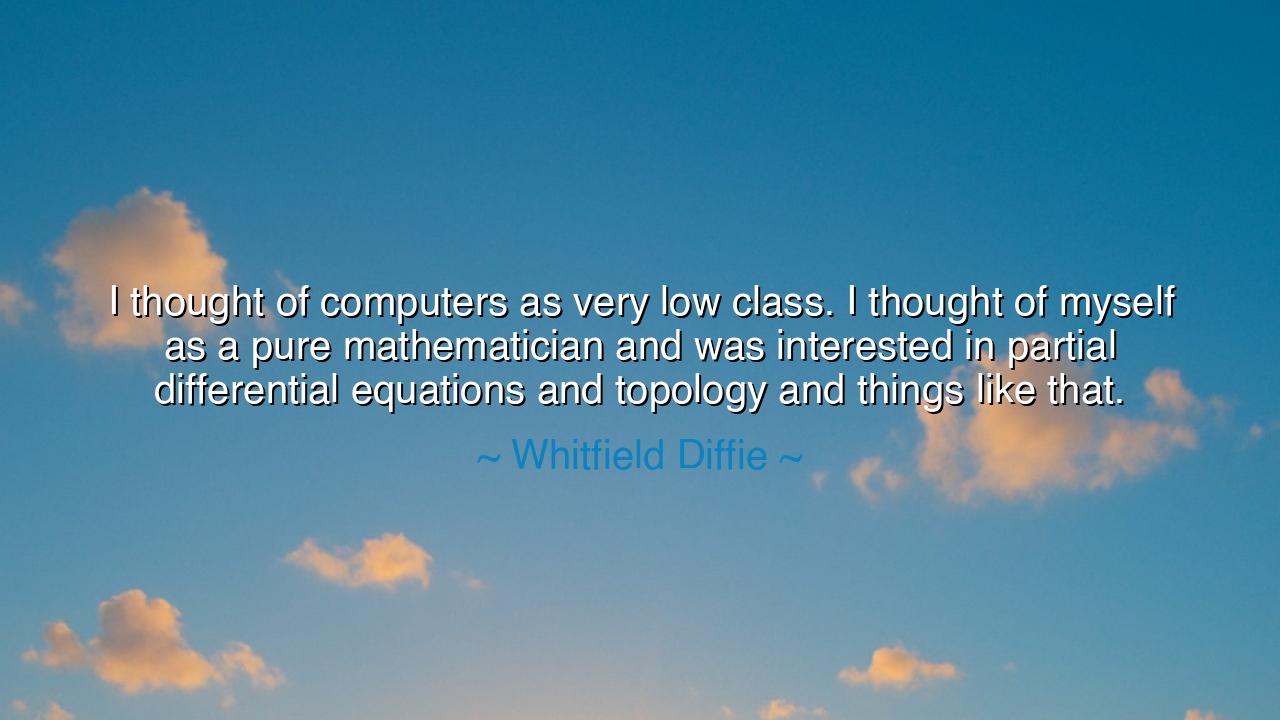
I thought of computers as very low class. I thought of myself as
I thought of computers as very low class. I thought of myself as a pure mathematician and was interested in partial differential equations and topology and things like that.






When Whitfield Diffie declared, “I thought of computers as very low class. I thought of myself as a pure mathematician and was interested in partial differential equations and topology and things like that,” he was offering a candid reflection on the early divide between theoretical mathematics and the emerging field of computer science. Diffie, whose work would later revolutionize cryptography, was speaking of a time when computers were viewed not as instruments of intellectual sophistication, but as tools for more practical, technical tasks. For those deeply entrenched in the world of abstract mathematics, the world of computers seemed crude and unrefined. This sentiment reveals a deep truth about the evolution of intellectual pursuits: the tension between pure theory and applied technology is as old as the very pursuit of knowledge itself.
In the ancient world, the tension between pure philosophy and practical application was embodied in the lives of figures like Plato and Aristotle. Plato, in his writings, held a profound belief in the transcendent nature of truth, a truth that could only be grasped through reason and abstract thought. For him, the pursuit of knowledge through mathematics and philosophy was the highest form of intellectual endeavor, far superior to the mundane concerns of the physical world. Aristotle, on the other hand, embraced a more pragmatic approach, blending theory with observation and empirical study. The debates between these two great minds reflect the same tension Diffie describes: the struggle between the pure and the applied, between philosophy and the tools we use to understand the world.
The origin of Diffie’s quote lies in the early days of computer science, a time when the field was still viewed by many as a technical pursuit rather than a domain worthy of intellectual respect. For mathematicians like Diffie, whose work focused on complex fields like partial differential equations and topology, computers were seen as a tool for engineering, not a medium for intellectual exploration. This perspective was shaped by the history of mathematics, where the highest echelons of thought were reserved for those who delved into abstract and theoretical realms. The rise of computer science challenged this view by demonstrating that applied technology could not only solve practical problems but could also lead to profound insights into the nature of computation, cryptography, and even philosophy.
Yet, Diffie’s view was not unique. The distinction between pure and applied mathematics has long been a source of tension. In the 18th century, Leonhard Euler, one of the greatest mathematicians, focused on abstract problems in geometry, yet his work also had practical applications that contributed to engineering and physics. Similarly, the mathematician John von Neumann, who contributed significantly to the development of computers, was initially a pure mathematician who bridged the gap between abstract theory and practical technology. Von Neumann’s work in computer architecture and the concept of algorithms laid the foundation for modern computing, showing that pure and applied mathematics need not be opposed but can complement one another.
The meaning of Diffie’s quote reveals the evolution of thought in the world of technology and mathematics. His early perception of computers as "low class" reflects a time when the purity of mathematical theory was seen as something far more noble than the practical application of machines. But over time, Diffie came to recognize the power of computing as it began to intersect with cryptography and mathematical theory. The field of cryptography, where Diffie made his mark, proved that computers could serve as tools for intellectual discovery and theoretical advancement, not just practical utility. In fact, it was through the application of computer technology that Diffie and Martin Hellman developed the Diffie-Hellman key exchange, a breakthrough in secure communication that changed the world of cryptography.
The lesson from Diffie’s words is profound: that intellectual pursuits must not be confined to rigid categories. The separation between pure mathematics and computer science, or between theory and application, is ultimately an artificial distinction. Just as Einstein combined the abstract realms of theory with the practical world of physics, Diffie’s work in cryptography shows how pure mathematical thought can lead to revolutionary applications. The key takeaway is that the boundary between theory and practice is not fixed; instead, it is fluid and can evolve as new tools, such as the computer, become available to expand our intellectual horizons.
Practical actions we can take from this wisdom:
-
Embrace the intersection of theory and practice: Just as Diffie bridged the gap between abstract mathematics and real-world technology, strive to find ways to apply your theoretical knowledge to solve real-world problems.
-
Avoid the trap of intellectual elitism: Don’t dismiss practical applications of knowledge simply because they are tangible. Recognize that technology can be as intellectually enriching as pure theory.
-
Foster interdisciplinary collaboration: Seek out opportunities to work with those in fields that combine theory and practice, whether in engineering, computer science, or mathematics.
-
Question traditional boundaries: Just as Einstein and Diffie broke down barriers in their respective fields, challenge the limits you place on your own thinking, especially when it comes to blending abstract ideas with practical applications.
For as Whitfield Diffie so wisely reflected, the separation between pure mathematics and applied technology is not a definitive one. Over time, as we expand the scope of human knowledge, we come to realize that the highest forms of intellectual achievement often emerge when theoretical and practical worlds collide. It is not enough to pursue one without the other; instead, it is in the balance between the two that true progress is made.






AAdministratorAdministrator
Welcome, honored guests. Please leave a comment, we will respond soon